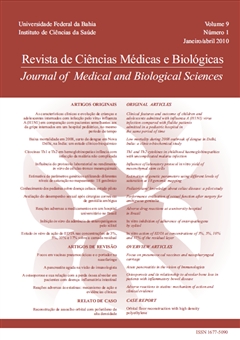In vitro inhibition of adhesion of enteropathogens by xylitol
DOI:
https://doi.org/10.9771/cmbio.v9i1.4640Keywords:
Xylitol – Bacterial adhesion – Gastrointestinal tract – Bacteria – Prevention and control – XylitolAbstract
Xylitol, a five-carbon polyalcohol, has several clinical applications such as the anti-adherent action on many bacteria. Currently,with the emergence of microorganisms resistant to conventional antibiotics, researches for new strategies are necessary, aimingat preventing and/or treating diseases caused by the presence of such pathogens. The present study aimed to evaluate xylitol’santimicrobial and anti-adherence activities on the strain Shigella flexneri ATCC 12022 and on the clinical strains (isolated frompatients) Shigella flexneri and Salmonella enterica serotype Typhimurium. In vitro, the antimicrobial and anti-adherent activitieswere tested using 0.5%, 2.5% and 5.0% xylitol. The slides of anti-adherent activity were analyzed by scanning electron microscopy(SEM). It was found that xylitol does not have antimicrobial properties on the strains tested. However, it was demonstrated, bySEM microphotographs, the inhibition of microbial adherence in slides treated with xylitol, and this is probably the mechanismof action of this compound. This study gives xylitol a greater added value, turning it into an appropriate biomolecule for useas an adjuvant therapeutic, alternative to the use of conventional antibiotics, for the treatment of recurrent infections of thegastrointestinal tract.Downloads
Download data is not yet available.
Downloads
Published
2010-10-27
How to Cite
Silva, A. F. da, Silva, S. S. da, Oliveira, M. G., & Raposo, N. R. B. (2010). In vitro inhibition of adhesion of enteropathogens by xylitol. Journal of Medical and Biological Sciences, 9(1), 46–53. https://doi.org/10.9771/cmbio.v9i1.4640
Issue
Section
ORIGINAL ARTICLES
License
The Journal of Medical and Biological Sciences reserves all copyrights of published works, including translations, allowing, however, their subsequent reproduction as transcription, with proper citation of source, through the Creative Commons license. The periodical has free and free access.


